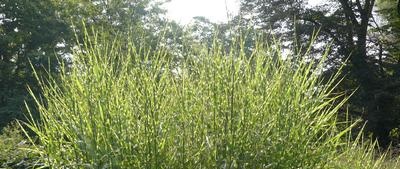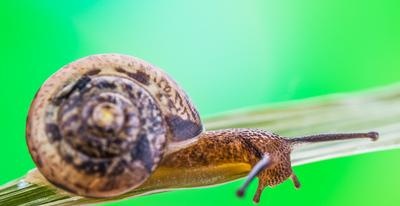|
 Miscanthus or fanny is a herbaceous plant native to Africa and America. Miscanthus is popular as an ornamental cereal. There are about 40 species in total. Miscanthus or fanny is a herbaceous plant native to Africa and America. Miscanthus is popular as an ornamental cereal. There are about 40 species in total.
A fannyk for garden decoration is planted around water bodies, on a lawn. Miscanthus can be dried, and knowing the techniques of floristry, you can make winter bouquets from it.

You will learn how to plant, care for and propagate a plant, protect it from pests and prepare it for the cold winter weather. Get acquainted with some varieties of amazing cereals.
Top dressing
Miscanthus needs to be fed three times during the summer. No fertilization is needed in the first year. In the second season, it is required to feed in mid-May with a urea solution. After a month and a half, it should be fed with humates. The third top dressing should contain potassium and phosphorus.
Plant decorativeness
Miscanthus grows from 80 cm to 2 meters. The root system, in search of moisture, penetrates deep into the soil. The plant has shoots with dense spike-shaped leaves, with a width of 0.5-1.8 cm, arranged in a fan. Each leaf grows up to 10-30 cm.

Miscanthus is a strong enough plant that pests and diseases do not damage it. The plant can be used as an ornamental plant and for composing a winter bouquet.
Planting a plant
You can plant miscanthus in the last week of March and until mid-April, when the ground warms up well, preferably in a lighted area of the garden, not in the shade.
- The soil must be chosen moist and fertilized, in no case clay or sandy.
- An adult plant should be purchased, because a young seedling will not be able to harden well before frost. An adult plant will get stronger before frost, if it is well covered, it will endure winter frosts without consequences.
- It is best to plant miscanthus in moist soil, near a body of water.
- The planting hole will have to be dug out spacious so that the plant's root system fits freely. First, a fertile layer is poured into the hole, then the seedling is lowered and carefully covered with soil. The soil is tamped by slapping it with palms.
- Then the seedling is watered with plenty of water.
- After planting, it is necessary to put restraints so that the plant cannot spread beyond its limits. Otherwise, he is able to fill the entire site. You can limit it by deepening fragments of iron or slate into the soil. They must be placed close to each other, without gaps, dropped into the soil to a depth of 20 cm, the limiter should rise 10 cm above the ground. The plant roots, in search of nutrients, are able to move over the edge of the limiter.
Watering the plant
Miscanthus is a moisture-loving plant, it needs to be watered often, you can even use a hose.
Plant care
Caring for miscanthus consists of constant weeding, especially in the first two years of development. Further, miscanthus will develop well and drown out weeds on its own. But the plant does not need loosening.
Bloom
Miscanthus begins to bloom in mid-summer.
In late August, some varieties of miscanthus lose their lower leaves, so the plant becomes less decorative. Experienced flower growers plant a tall plant next to muscanthus, like hosts, growing up to half a meter. Hosts, like miscanthus, are also capable of growing in moist soil.
Reproduction
Vegetatively. For plant propagation, it is easier to use the vegetative method. As a rule, miscanthus grows quickly, shoots die off all the middle of the bush. Therefore, to preserve the decorative effect of the bush, it will have to be transplanted, at the same time it is useful to divide it in order to propagate. It is better to carry out this procedure in May-June. The bush should be cut with a sharp shovel in order to damage less.

Seeds.Miscanthus grown from seed becomes decorative only for 3-4 summers. The seed is placed in a peat pot, when it sprouts and the soil warms up, the plant is transferred to the garden. Such a plant does not retain varietal characteristics. Preparation for wintering
Miscanthus varieties
There are about 40 varieties of Miscanthus. Here is some of them.
1. Miscanthus giant... A plant with erect stems up to 3 meters high. The width of the dark green leaf reaches 25 cm, decorated with a white stripe in the middle. The leaves grow like a fan from the stem.
The plant blooms in late August with panicles of pink color, which gradually changes to silver. In cold summers, this type of miscanthus may not bloom. Better to plant in the background and next to a tall plant.
2. Miscanthus chinese... In the wild, it grows in China, Japan and southern Russia.
The plant has short roots and erect stems that grow up to 3 meters. The surface of the leaf is rough and narrow, and the median vein is ribbed.
It blooms with spikelets up to 0.7 cm long, concentrated in a wide panicle. Cultivated since 1875, it can withstand winter if well mulched and covered with foil.
Chinese miscanthus is in demand by a florist, especially since more than 100 varieties have been bred. They have different colors, sizes and outlines of the bush. Some of them, for example Blondeau, can be grown in the middle lane and even without shelter. The bush grows up to 2 meters.
3. Miscanthus Ferner Austin... The bush grows up to one and a half meters. The leaves are narrow with a white stripe in the middle, which turns brick-red at the end of August. Flowers appear in August in the form of red panicles with white tips, they gradually turn to a silvery-bronze color.
4. Miscanthus morning light... It has narrow green leaves along the edges with a white stripe. Flowering occurs late and not every summer.

Some varieties of miscanthus do not need shelter for the winter. But gentle species must be protected not only from frost, but also from severe frosts. A gradual decrease in temperature is not dangerous for the plant. But the sudden drop in temperature causes miscanthus to die. If a cold snap is expected, then the miscanthus is covered with a film, leaving an outlet for air. Previously, the plant should be mulched with sawdust or peat.
Miscanthus can be a decoration for any garden.
Vaulin B.V.
Read now
All recipes
|
 Miscanthus or fanny is a herbaceous plant native to Africa and America. Miscanthus is popular as an ornamental cereal. There are about 40 species in total.
Miscanthus or fanny is a herbaceous plant native to Africa and America. Miscanthus is popular as an ornamental cereal. There are about 40 species in total.










